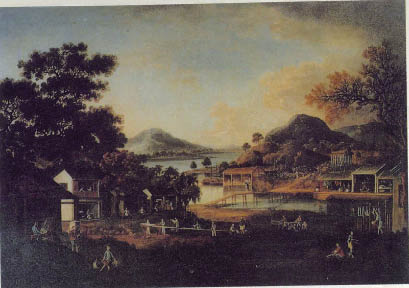|
Oil Painting in China
By staff reporter WU BING
OVER the past few centuries, Western oil painting made its way into China's traditional art world and founded forms of vivid expression.
Oils Come to China
In 1583, the Italian Jesuit missionary Matteo Ricci came to China and introduced Western oil painting to Chinese people for the first time.
At the beginning of the 18th century another Italian missionary, Giuseppe Castiglione (1688-1766) followed in Ricci's footsteps, and for the next 50 years worked in China as a royal artist, serving three emperors of the Qing Dynasty: Kangxi, Yongzheng and Qianlong. He created a large number of oil works, but they were only seen by court nobles, and so exerted no influence over ordinary Chinese people.
 |
| Weaving and Dyeing Mill, a 19th century "painting for export." |
Later in the 19th century, "paintings for export" became quite popular in regions such as Guangzhou and Macao. Many local painters emerged specializing in this field. Their paintings utilized oil and gouache techniques learnt from Western painters, and their works were generally sold in Western countries. The paintings mainly focused on landscapes, buildings and people's lives in the Pearl River Delta. Guan Qiaochang (Lamqua, 1801-1854) and his brother Guan Lianchang (Tingqua, 1809-c.1870) were the most influential of this group.
During the same period many overseas oil artists visited China. George Chinnery (1774-1852) was the most representative. He had been a follower of the eminent British painter Joshua Reynolds (1723-1792) and entered the Royal Academy of Art when he was 18 years old. In 1825 Chinnery moved to Macao, where he made substantial efforts to promote exchanges between the Chinese and Western art worlds. Guan Qiaochang was one of his favorite students. Guan mastered painting skills and was good at portraiture, but his works lacked distinct characteristics. Despite this, he is generally considered by modern researchers to be the earliest important Chinese oil painter.
In the early 20th century, painters going abroad to study, such as Li Tiefu (1869-1952) and Xu Beihong (1895-1953), also brought Western oil painting techniques back to China.
Li Tiefu went to the United States at age 16, and then studied painting in Canada for nine years. During that time, he won the Oil Painting Competition of the Arlington School of Art and was granted a scholarship. In 1896, he returned to the United States where he studied with two famous American painters, William Merritt Chase (1849-1916) and John Singer Sargent (1856-1925), mastering the essence of his teachers' skills. In 1930, Li finally ended his 40-year expatriate life and returned to China. His skill at using pigments, as well as his painting techniques and composition abilities, were equal to the top-grade American painters of the time, and his artistic attainments received wide recognition. Sun Yat-sen (1866-1925) once extolled him as "the foremost figure in the Eastern Asian painting circle."
Although Chinese painters mastered oil techniques quite early, their work was mainly done for commercial purposes or out of personal interest, and mostly appreciated by Westerners. All of Guan Qiaochang's paintings flowed into Europe, and Li Tiefu spent most of his life overseas.
| 